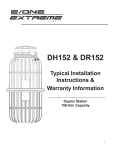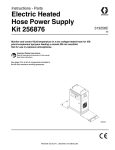Download T260 Alternating Panel Service Information
Transcript
SEWER SYSTEMS T260 Alternating Panel Service Information Environment One Corporation Contents Panel Basics ......................................................................................................................................... 3 Panel Operation .............................................................................................................................. 3 High-Level Alarm Operation .......................................................................................................... 3 Manual Run Operation ................................................................................................................... 3 Both-Pump Operation (AUTO/BOTH Switch) ................................................................................ 3 Changing Alternating Time (NORMAL/TEST Switch & Alternator Cycle Time Jumpers) ............ 3 System Status LED Operation ........................................................................................................ 4 Alarm Dry Contact ......................................................................................................................... 4 Alarm Dry Contact Servicing Note ................................................................................................ 4 Startup Procedures .............................................................................................................................. 5 Troubleshooting ................................................................................................................................... 7 Figures Figure 1 - Nuisance Alarm Delay Jumper ........................................................................................................... 8 Figure 2 - Alternate Cycle Time Jumper & Normal/Fast Switch ........................................................................ 8 Figure 3 - PC Board Operation Picture ............................................................................................................... 8 Figure 4 - T260 Alternating Panel Installation Wiring (PA1788P01) ................................................................... 9 1 Panel Basics Service Safety: Only people trained in electrical safety and on Environment One equipment should work on these controls. Anytime the panel or pump is serviced, the power must be turned off, including the power used on the dry contact (which is a separate power supply in many cases). Never make any changes on the alarm/alternating PC board unless the power is off. Failure to turn off power could cause personal harm as well as possible damage to the equipment. Panel Operation At any given time, only one pump has full line voltage going to it; this is the lead pump. The lead pump operates off its own controls and remains the lead pump for a set amount of time (24 hours is the factory preset standard default). Per the factory default, the panel will switch the power from the lead to the lag pump every 24 hours. Pump 1 will be on, or lead, for 24 hours, then Pump 2 for 24 hours, then back to Pump 1 for 24 hours, and so on. High-Level Alarm Operation Both pumps have high-level alarm pressure switches; if either alarm switch closes, the circuit will go into alarm mode. During the alarm mode, the panel will apply power to both pumps and delay the alarm light and horn 3.5 minutes. This delay is to prevent nuisance alarms in the event of an unusually high flow. If the station is still in high-level alarm after the delay, the light and horn will activate. To silence the horn, push the button located at the lower left-hand corner outside the panel box. The alarm will clear once both alarm switches in the pumps open (or clear). The delay on the alarm may be eliminated by moving jumper on J2 to the right two pins (Figure 1). Manual Run Operation Two manual-run rocker switches are located on the PC board above the lower terminal blocks. The lead, or powered, pump will run while its rocker switch is depressed. The yellow LED’s, located in the middle of the PC board, indicate which pump is powered. Both-Pump Operation (AUTO/BOTH Switch) To run both pumps simultaneously, slide the AUTO/BOTH switch, located in the middle of the board, down; this will energize both contactors in the panel and supply power to both pumps all the time. The pumps will operate automatically and independently as the water level in the tank rises. You will see both yellow LED’s are on with the slide switch in this position. Either or both manual-run switches will run its corresponding pump. Slide the switch up to put the panel back to AUTO for normal operation. This feature is also used when Pump 1 or Pump 2 is not in use. When the AUTO/BOTH switch is down in the BOTH position, contactors 1 and 2 will be energized. If either of the pump breakers is turned off, the other pump will remain energized until the switch is moved to AUTO. Changing Alternating Time (NORMAL/TEST Switch & Alternator Cycle Time Jumpers) Service Safety: Always turn all power off (including power to dry contact) before servicing or making any changes on the PC board. 2 Located on the top left-hand side of the PC board is a series of pairs of pins (position J1 on the board). By selecting different pins with the jumper block, the time the panel takes to alternate from one core to the next will change. The first two pins to the left are to be selected, using the jumper block, to have the panel alternate every 8 days, the next set in is 4 days, then 2 days, then 1 day and finally 3 hours. In Figure 3, the jumper is on the 3-hour setting. The factory sets the jumper block at the 1-day position, which is the second set of pins from the right, or the fourth set from the left. To test the PC board to ensure the operation, move the jumper to the 3-hour position and slide the NORMAL/FAST switch to the FAST position. Turn on the power to the alarm PC board and both cores. The panel should energize Contactor 2 first, and in 3 to 4 minutes it should switch to Contactor 1. The panel will switch between Contactors 1 and 2 every 3 to 4 minutes. When the test is complete, turn off all power, switch back to the NORMAL position, and select the proper jumper position for the time you need to alternate between the two cores. Turn on the power. System Status LED Operation Six LED’s are located on the control board. See Figure 3 for the location of each LED. RED: Two red LED’s are located in the center of the PC board. These lights indicate the alarm status of the station. Each pump has its own light. GREEN: Two green LED’s are located just above center on the PC board. They light when its pump is running. YELLOW: Two yellow LED’s are located just below center on the PC board. They indicate which pump is the lead, or powered, pump. The lag LED will be dimly lit (about ¼ bright). Alarm Dry Contact The dry contact is located on the PC board, at the bottom, lower left-hand corner. This connection is used when an auxiliary (secondary) alarm is needed. Power is fed to the one terminal; the other terminal is the return, which goes to the device you want to energize when the station goes into alarm. If the panel has four similar relays populated on the PC board, it is equipped with a standard dry contact feature. The contacts can only operate if power is going to the PC board. If the panel has six similar relays populated on the PC board, it is equipped with the option for dry contact to operate as a Power Loss High Level Alarm. If the power fails and the station fills to the high level, the contact will close, completing the circuit to your alarm device. This feature would need a battery-supplied circuit to operate. This feature is meant to be used with 24-volt devices and lower. Environment One recommends the E/One Sentry Unit with this feature. Alarm Dry Contact Servicing Note The power must be disconnected from the dry contact when any service work is performed on the panel, the pump or the station. The breakers in the panel have no control over the power to the dry contact. 3 Startup Procedures The control panel should be operationally tested once the installation is complete and before the station is to go online. Failure to due so could cause damage to the product. 1. Double check all wire connections in the panel, including the incoming power to the breakers and the pump leads. Follow the wiring pictorial on the panel door for proper placement of wires. NOTE: All panels may not be wired the same due to additional options and/or factory changes. Always refer to wiring diagram inside of panel door for correct wiring. 2. Check incoming power to ensure that the phases at the breakers match the panel wiring pictorial on the panel door. Also check to see that the pump leads are grouped together. 3. Check the power source coming to the panel. The voltage must be within 10 percent of the voltage listed on the panel nameplate (216 to 264 for 240V USA). If the voltage is low, you must install a transformer to adjust it within these limits, or the station will not run properly and may cause equipment damage. 4. Perform a short test to each core per service manual startup procedures. Table 1 shows the readings you should get when checking resistance between the wires coming from each core. Set your meter according to the chart below. If readings taken are not close to the readings given, troubleshoot the supply cable and pump core for the cause. Table 1 assumes the station is dry, or at least below the turn-on level of the pump cores. (For USA, 240V pumps only; refer to your regional service maual for correct values.) Wire 1 Wire 2 Meter Scale Correct Reading Black Red 2000K ohm or 2 meg ohm 15 k White Red 200K ohm 1.5 k Green Black, White, Red 2000K ohm or 2 meg ohm Open, no reading Table 2 assumes the station is full, above the pump cores’ alarm level. (For USA, 240V pumps only; refer to your regional service maual for correct values.) Wire 1 Wire 2 Meter Scale Correct Reading Black Red 2000K ohm or 2 meg ohm White Red 200K ohm Orange Blue 2000K ohm or 2 meg ohm 0 (alarm sw. closed) 2000K ohm or 2 meg ohm Open, no reading Green Black, White, Red 4 0 1.5 k 5. Open all discharge valves in the system. 6. Turn on the single-pole control/alarm circuit breaker, located on the right-hand side of the group of breakers. A yellow light should illuminate on the control board; if not, check the voltage between the top of the breaker and the neutral terminal in the terminal block. The voltage should read within 10 percent of 1 leg of power. 7. Fill the tank with water until the alarm turns on. Remember, there is a 3.5-minute delay between the alarm closure and the panel alarm. Push the silence switch located under the panel on the left-hand side. 8. Turn off the breakers in the panel. In the center of the PC board, there is a slide switch that changes the panel from AUTO operation to BOTH pump operation. See Figure 1 for the location of this switch. Slide the switch down to select both. Turn on the alarm breaker. 9. Connect an amp probe to the white lead going to Pump 1. Turn on the breaker for Pump 1. The amperage should be between 5 and 8 amps. The green LED for Pump 1 should illuminate. 10. Once the pump one runs down and turns off, connect the amp probes on the white wire for Pump 2. Turn off the breaker for Pump 1 and turn on the breaker for Pump 2 and run water into the tank until it turns on. The amperage should be between 5 and 8 amps. The green LED for Pump 2 should illuminate. 11. Turn off all breakers. Slide the AUTO/BOTH switch up to the AUTO position. 12. Turn on all breakers. 13. Log the serial number, voltage and amperage of each pump while it is running. PUMP ONE Serial # ______________ Voltage ___________ Amperage __________ PUMP TWO Serial # ______________ Voltage ___________ Amperage __________ 5 Troubleshooting DANGER! VOLTAGE KILLS! Always turn off all power, including the power to the dry contacts, while working in the control panel. Only people trained in electrical safety and on Environment One equipment should work on these controls. NOTE:If the alternating controller fails to operate and the pumps appear good, the pumps can be wired directly to the breakers. Disconnect the black and white pump wires from the contactors and connect them to the output side (top side) of the pump breakers. Ensure that the singlepole control/alarm breaker remains off. Once the pump breakers are turned on, the pumps will operate independently. This is a temporary fix while waiting for parts. Always check first that the connections within the panel are properly connected. 1. No LED’s light on the control board after the single-pole control/alarm breaker is turned on. Ensure that the voltage between the top of the single-pole control/alarm breaker and the neutral terminal block is within 10 percent of 1-leg of power. Check the incoming power at the bottom of the breaker and neutral. If there is no or low power, check between L1 and L2; the voltage should be within 10 percent of the voltage listed on the panel nameplate. If not, repair the incoming power source. If there is proper voltage, check the power source for proper neutral. Delta power sources, commonly found in businesses, will not produce volts when drawing any amount of current from a phase leg and ground (or neutral), but with everything off, a digital meter may read voltage. If the voltage between the top of the breaker and the neutral terminal block is good, with the single-pole control/alarm breaker turned on, check the voltage between one of the orange terminals (alarm board to pump) on the terminal block on the bottom of the board to neutral. The reading should be above the minimum for 1-leg of the line voltage. If not, check the wiring between the PC board and the power source. If the voltage is good, replace the PC board. 2. The red LED illuminates, but the pumps will not run. Check the voltage coming into the motor contactors (all breakers need to be turned on; the contactors are located above the breakers) and test between terminals 1L1 and 5L3. The voltage should be within 10 percent of the panel nameplate voltage. If not, check the wiring and power in and out of the breakers. Next, check the voltage on the powered contactor. Check the voltage between terminals 2T1 and 6T3; the voltage shown is the same as the reading taken from the top of the breakers. If power is low, replace the contactor. If the contactor is not powered, check the voltage to the control board. Ensure the voltage is getting to the coil on the relays by checking terminals A1 and A2. 3. The voltage coming to the station is lower than the voltage listed on the panel nameplate. The pump will run down to 10 percent less than the voltage listed on the pump and panel nameplates. During peak usage times, the voltage may drop lower, and then the pumps will not start reliably. The low voltage could cause damage to the pump, panel and/or controls. It is recommended that a transformer is installed to boost the voltage when the source is too low. 6 Figure 1 - Nuisance Alarm Delay Jumper Figure 2 - Alternate Cycle Time Jumper & Normal/Fast Switch Figure 3 - PC Board Operation Picture Alternate Cycle Time Jumper (8-day, 4-day, 2-day, 1-day, 3-hour); Factory Default: 1 Day Nuisance Alarm Delay; Factory Default: Delay (2 left pins) NORMAL/FAST Slide Switch NORMAL down (FAST speeds up cycling by 60 times faster or 3 hours = 3 minutes); Factory Default: NORMAL Pump Run Indicator Green LED Alarm Indicator Red LED Lead or Active Pump Indicator Yellow LED AUTO/BOTH Pump Selector Slide Switch (BOTH selected is down); Factory Default: AUTO Pump 1 & 2 Manual Run Rocker Switch Dry Contact 7 Figure 4 - T260 Alternating Panel Installation Wiring (PA1788P01) Note: Your panel may contain different options than shown here. 8 A Precision Castparts Company Environment One Corporation 2773 Balltown Road Niskayuna, New York USA 12309–1090 Tel: (01) 518.346.6161 Fax: 518.346.6188 www.eone.com PA1800P04 Rev. A























